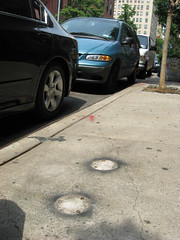 Stephen Rex Brown All that’s left of the rack.
Stephen Rex Brown All that’s left of the rack.The bike rack on East Fourth Street that a scofflaw cyclist claimed as his own has been removed.
Kyle, the East Fourth Street resident who had his bike stolen from the rack last weekend, noticed that the rack was gone this morning. Sure enough, where once was an arched beam with “Private Bike Rack” painted on it there is now nothing more than six bolts in the sidewalk.
“It’s obviously a bummer that the bike rack had to go, but it’s better than having to put up with someone’s abuses,” said Kyle, who did not wish to give his last name for fear of a confrontation with the rack’s “owner.”
He added, “That guy probably wasn’t going to relent. If it were the bike rack or the guy, the only thing that would have changed is the rack.”
The Local is awaiting a response from The Department of Transportation, regarding whether it removed the rack between Avenues A and B. Back in October the department confirmed that it hadn’t installed the rack, and that it was illegal to claim it as one’s own. In fact, the department can bill whoever installed the rack for the expense of removing it. Of course, that seems unlikely given that the owner has never come forward, though rumors abound.
Update | 4:31 p.m. A spokeswoman for The Department of Transportation confirmed that workers removed the rack today, and that it had received no complaints about it since October. Read more…
 Melvin Felix Robin Manning glides down a zip line at Union Square Park.
Melvin Felix Robin Manning glides down a zip line at Union Square Park.Some lucky pedestrians around Union Square got to zing down a 160-foot-long zip line before going off to work this morning.
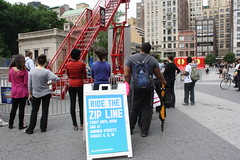 Melvin Felix A group waits in line to ride the zip line.
Melvin Felix A group waits in line to ride the zip line.“It was so fun,” said Robin Manning, 48, who lives in Hanover Square and said she was late on her way to therapy.
The zip line is one of several free activities associated with Summer Streets this year. For three Saturdays in August, the city will clear traffic on nearly seven miles of streets and turn them over to pedestrians. This year’s events, which will take place from 7 a.m. to 1 p.m. during the first three Saturdays of August, will include a 25-foot climbing wall, sports-themed activities such as dance and yoga classes and, of course, the zip line.
“You don’t need a cup of coffee,” said Department of Transportation Commissioner Janette Sadik-Khan, who glided down the long cable at Union Square twice this morning. “You can start your morning off with the zip line.”
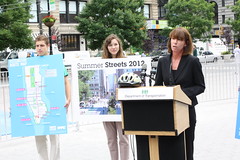 Melvin Felix Department of Transportation Commissioner
Melvin Felix Department of Transportation Commissioner
Janette Sadik-Khan.Ms. Sadik-Khan, who spoke with a bike helmet at her side (they were given out at the event) said community groups would also offer family-friendly activities, dubbed Weekend Walks. Fourth Arts Block will host the East Village’s Weekend Walks on August 18, 19, 25 and 26, from 1 p.m. to 8 p.m. at East Fourth Street between Second Avenue and Bowery.
 Phillip Kalantzis-Cope
Phillip Kalantzis-Cope Good morning, East Village.
The Times looks back on what made Lakeside Lounge so special (“once, while Joey and Dee Dee Ramone played, audience members watched the police raid a nearby crack house and line suspects up against the picture window beside the stage”) and gives a clue as to why it’s closing at the end of the month: “[Owner Eric] Ambel said rent and expenses had more than quadrupled since the mid-1990s, forcing him and Mr. Marshall to face the prospect of deviating from the formula that had served Lakeside, its musicians and its patrons so well.” According to WNYC, the rent was $9,000 a month.
Flaming Pablum uses the closing of Lakeside as an excuse to look back on five other bygone dive bars, including Alcatraz on St. Marks Place, an “endearingly seedy joint that catered to acolytes of all things loud, boozy and rude.”
With the average rent in Manhattan at $3,418 a month and the vacancy rent at just 1 percent despite the lagging economy, The Times lays down some real talk: “For those who find buying a home in New York City is not an option — whether because of bad credit, tougher lending standards or lack of a down payment — the choices are limited and often unappealing.” If you are buying, the Daily News points out that there are still deals to be found in the Lower East Side. Read more…
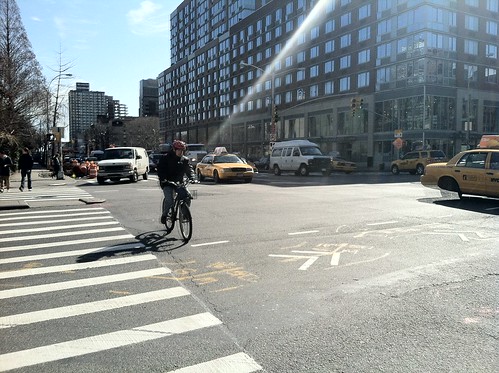 Natalie Rinn The intersection of Bowery and Houston.
Natalie Rinn The intersection of Bowery and Houston.Ten East Village intersections have been targeted for improvement by the Department of Transportation, including one – the intersection of Houston and Bowery – that has seen a bevy of biking accidents.
Last night at a joint meeting of Community Boards 2 and 3, the department unveiled the findings of a two-year survey covering a southern portion of the East Village as well as portions of Greenwich Village, NoLIta, and the Lower East Side. The study, which can be seen below, identified 15 intersections (10 of them in the East Village) that the city will target for future makeovers, including five intersections (one in the East Village) that were said to be “high accident locations.” From 2008 to 2010, the intersection of Avenue A and First Street saw 25 accidents, 18 of which resulted in injuries and one of which resulted in the death of a pedestrian.
Though the intersection of Houston Street and Bowery wasn’t among those identified by the D.O.T. as the most dangerous, it was that crossing – the city’s most accident-prone intersection for bicyclists from 1995 to 2009 – that initiated the study to begin with, and it was the one most East Village residents spoke up about. The study found noticeable congestion at the intersection, where 10 to 15 percent of daytime vehicles were trucks, and noted that it was in need of changes to better accommodate turns. Read more…
Last week we learned that East Houston Street and Bowery was the most dangerous intersection in the city for cyclists. New information culled from the same set of State Department of Transportation data reveals that Community Board 3 (which includes the East Village, Lower East Side, and part of Chinatown) was the fifth-most dangerous part of the city for pedestrians from 1995 to 2009. The statistics, compiled by the advocacy group Transportation Alternatives, show that 4,138 accidents involving cars and pedestrians occurred during the 14-year span within Community Board 3. Community Board 5 — which covers Union Square, Times Square and much of Midtown — was by far the most dangerous district for pedestrians, with 8,604 accidents.
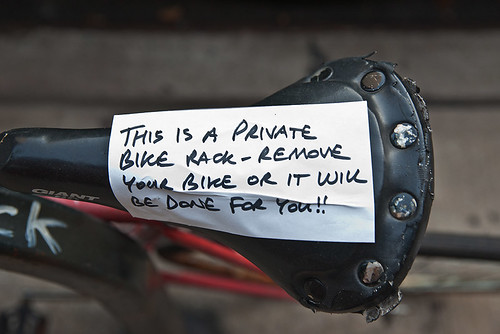 Noah Fecks
Noah Fecks The city’s Department of Transportation confirmed late yesterday what seemed obvious: you can’t claim a bike rack on a sidewalk as private, even if you installed it yourself.
The Local submitted the oddball inquiry yesterday after reporting on the mystery of the “private” rack on East Fourth Street. A local plumber told The Local he installed the rack at the request of Flash Courier Service, and assumed it would be available to the public. But as it turned out, someone has claimed the rack as his own, and left notes warning that the “trespassing” bikes will be forcibly removed.
A spokeswoman for the Department of Transportation said that the rack did not appear in city records. “Still, even if a permit is issued for installation, that does not mean the bike rack is for the exclusive use of the owner if it is installed on a public sidewalk,” the spokeswoman added. Read more…
State Senator Daniel Squadron and City Councilwoman Margaret Chin urged the Department of Transportation to improve safety on Delancey Street today in the wake of last week’s deadly accident that killed a 52-year-old cyclist. As the Lo-Down reports, the thoroughfare had a reputation for danger prior to the most recent tragedy. Earlier this month, The Local reported that a significant number of the city’s dangerous intersections are on the Lower East Side — of those, most are on Delancey Street.
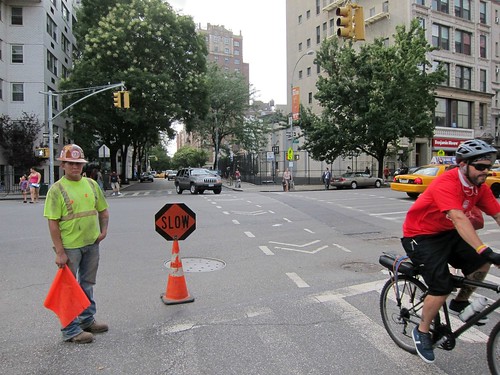 Scott Lynch
Scott Lynch Good morning, East Village.
East Village cyclists have been put on notice. City workers plan to discard several abandoned bikes near East First Street between Avenue A and First Avenue, according to a Department of Transportation sign spotted by EV Grieve. Better pick yours up by the end of the day.
The New York Daily News profiled former CBGB bartender Jane Danger, owner of Jane’s Sweet Buns. The shop, at 102 St. Marks Place, features baked goods with hints of alcohol, like a Rum Runner bun with nutmeg, cinnamon, raisins, brown sugar, Galliano liqueur and aged rum.
Finally, Neither More Nor Less, Marty After Dark, EV Grieve, and Gothamist have photos from Saturday’s protest against East Village gentrification. Activist John Penley and his crew started at East Third Street, found its way to the BMW Guggenheim Lab and ended at what used to be Mars Bar. A poem was read. A cigarette was lit. Signs were waved, and then the protestors went home.
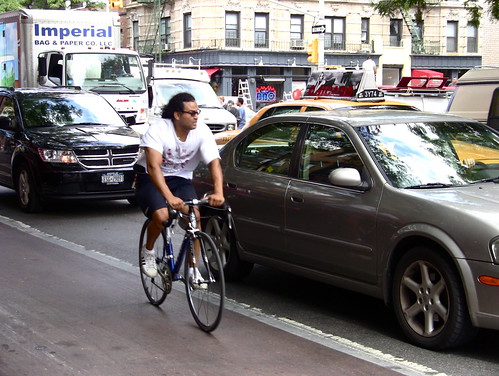 Leila Samii
Leila Samii Earlier this week, the Daily News pointed to the intersection of Essex and Delancey Streets as one of the deadliest in the city. Where bicycle accidents are concerned, it isn’t the only dangerous street crossing on the Lower East Side. In fact, data shows that the neighborhood boasts many of the intersections most prone to bicycle crashes.
The Local obtained records from the New York City Department of Transportation of cycling accidents in 2008 and 2009, the most recent years available. The records reported all intersections where four or more cycling accidents occurred in 2008, and three or more in 2009.
Of the 33 intersections on the list, nine are on the Lower East Side (three of those nine are on Houston Street, the border of the East Village). The data reported a total of 45 crashes at those intersections.
Midtown was the second most sketchy neighborhood with 38 crashes across its accident-prone intersections.
Read more…
 One Animus Arts Collective artist constructs a Flaming Cactus Saturday night
One Animus Arts Collective artist constructs a Flaming Cactus Saturday nightThe “WALK MAN” that was erected in Tompkins Square Park over the weekend has already been vandalized (DNA Info has the story), but another art installation is still standing. Over the weekend, a group of roughly ten artists calling themselves the Animus Arts Collective transformed fourteen East Village lampposts into “Flaming Cactus” displays.
You may have seen some of the lampposts at Astor Place; four similar lampposts, festooned with fluorescent cables to resemble cacti, are located on Governor’s Island.
Officials with the New York City Department of Transportation commissioned the project in order to mark the route of the D.O.T.’s fourth annual Summer Streets program. Read more…
Earlier this year, we told you about the frustrations some M15 riders share regarding local bus service. In response to rider complaints, Community Board 3 tonight voted to file a joint resolution requesting that New York City Transit and the Department of Transportation consider relocating Select Bus Service stops so they are adjacent to or combined with local stops. Board members hope that riders will have quick and easy access to both local and Select Bus Service.
— Chelsia Rose Marcius
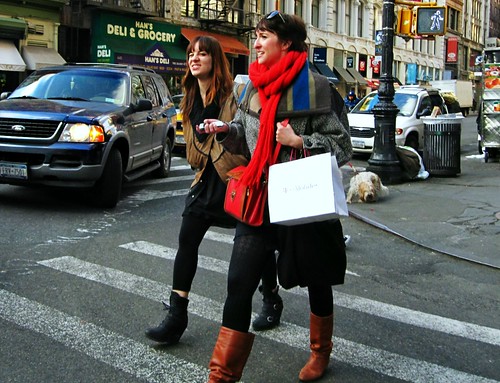 Michelle Rick
Michelle RickIf you had to identify one defining feature of life in Manhattan, it just might be pedestrianism. There are places where calling someone or something “pedestrian” is an insult; this isn’t one of them. Here, “pedestrian” is an identity to share and be proud of. It does occasionally need defending.
Only a minority of us have cars, but every New Yorker walks and lives near things worth walking to (no matter how often we also take taxis or Zipcars or anything else). Our street grid, formed by the 1811 Commissioners’ Plan, predates the automotive invasion of American space by nearly a century. We’re the pre-automotive Americans, by design and by history as well as by inclination. And if factors like climate change, oil shortages, energy costs, Middle Eastern warfare, and rising awareness of what cars do to human bodies all suggest that the automotive era won’t last forever, we’re ready for post-automotive life, too.
On the East Side, the human/vehicular competition is particularly intense, and with the tire tracks on people’s backs to prove it, a coalition of community groups led by the nonprofit group Transportation Alternatives (along with the East Village Community Coalition, East Harlem Preservation, Civitas, Upper Green Side, and others) has developed an East Side Action Plan to define goals for the improvement of street safety involving multiple city agencies. The East Side, particularly the East Village, is a logical place for this: the area from Chinatown up to East Harlem accounts for only 8 percent of the city’s population but 22 percent of its pedestrian commuters, 13 percent of its bike commuters – and 11 percent of its “fatal and injurious” crashes.
Read more…
 Kathryn Kattalia
Kathryn KattaliaDuring the 20 years that she has lived on East Fourth Street, Frances Bush has seen dozens of accidents involving pedestrians rushing across the Bowery — a wide avenue stretching roughly a mile from Chatham Square in Chinatown to Cooper Square in the East Village.
“You have cars coming off of Houston onto Bowery and they’re going quite rapidly,” said Ms. Bush, 50. “With the construction and the bike lanes, people get confused. A lot of safety has to do with that.”
With traffic running north and south, the Bowery is one of the main arteries of the East Village. It is also one of the deadliest.
Of the 109 pedestrians hit and killed on Manhattan’s streets between 2007 and 2009, seven fatalities took place on the Bowery, making it the fourth most dangerous road for pedestrians in the borough, according to a newly released report by the Tri-State Transportation Campaign.
For a longtime Bowery observer like Ms. Bush, that comes as no surprise.
“People don’t abide by the law,” she said. “They don’t follow the lights, they don’t follow directions. It gets real crowded here and people get distracted.”
Read more…
There is no shortage of opinion when it comes to the speed hump installed in November 2009 on East 10th Street between Avenue A and First Avenue.
But now that the hump has been installed for nearly a year, many residents and storeowners are concerned about its effectiveness or confused by its location – or simply annoyed by it.
After several car accidents involving children in front of the 10th Street Boys’ Club, residents and neighbors from the local community board lobbied for the installation of a speed hump on the street.
Roadway layout and driveway locations are major factors that determine where the city places speed reducers, according to a spokeswoman with the Department of Transportation. The department determined the 10th Street hump’s current location as the best place to maximize safety for pedestrians crossing the road.
NYU Journalism’s Alexandra DiPalma, Sarah Tung and Rachel Wise describe the reactions of those who live and work near the speed hump.
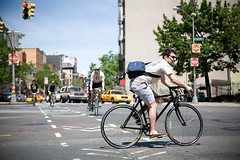 Emily Anne Epstein By one analysis, the redesigned bike lanes across the city have resulted in safer conditions for cyclists, motorists and pedestrians.
Emily Anne Epstein By one analysis, the redesigned bike lanes across the city have resulted in safer conditions for cyclists, motorists and pedestrians.Amid all the opinions raised for and against the city’s new street designs, Gaetano Puglio, manager of the Bean Café, minces no words: he doesn’t like them. Especially not the one in front of the café on First Avenue at East Third Street, the site of a collision on Labor Day.
Around 1:30 a.m. on Sept. 5, a Jeep Cherokee SUV heading west on Third Street tried to turn onto First and collided with a northbound taxi. The cab veered across the First Avenue bike lane and leapt the sidewalk, injuring five people, crushing a bicycle, and taking out the Bean’s front window. One bystander was injured critically and needed surgery at Bellevue. The collision remains under investigation and neither driver has been charged.
Like many observers, Mr. Puglio wondered if last summer’s redesign of the traffic lanes on First Avenue was a contributing factor. The redesign shifted the western parking lane inward to create a protected (“Copenhagenized”) bike lane and reserved the easternmost lane for buses. Mr. Puglio said that he always viewed the previous design – with a row of parked cars abutting the curb – as “a barrier to any kind of accident.”
But an independent analysis by the city’s former traffic commissioner shows that when lanes were redesigned in other parts of the city, the result was safer conditions for drivers, cyclists and pedestrians.
Read more…
 Mariya Abedi Some East Village business owners say that recently installed bike lanes are adversely affecting their deliveries.
Mariya Abedi Some East Village business owners say that recently installed bike lanes are adversely affecting their deliveries. New bike lanes may be a welcome sight for cyclists in the East Village, but after two months they’re still not going over well with some small businesses.
When transportation officials placed bike lanes between the sidewalk and a parking zone, they separated delivery trucks from direct access to many local stores. Some business owners say they’re having more difficulties with deliveries as a result.
The Department of Transportation has begun installing loading zones but even that step may not completely solve the problem.
Read more…


















